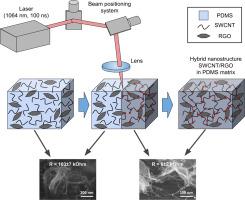Dry electrodes based on carbon nanotubes-graphene hybrid nanostructures for long-term ECG monitoring
IF 5.1
3区 材料科学
Q2 MATERIALS SCIENCE, COATINGS & FILMS
引用次数: 0
Abstract
Dry electrodes for long-term ECG monitoring based on composites of hybrid nanostructures from single-walled carbon nanotubes (SWCNT) and reduced graphene oxide (RGO) flakes in a polydimethylsiloxane (PDMS) matrix under laser irradiation have been developed. A method for forming liquid dispersion for uniform homogenization of carbon nanomaterials within the composite volume has been developed. It was established that exposure of the composite to laser irradiation with a wavelength in the near-infrared spectral range and intensity of 15 kW/cm2 leads to a 13-fold reduction in resistance to 8 ± 2 kΩ due to the formation of SWCNT/RGO hybrid nanostructures. It was obtained that the formation of conductive networks in the PDMS matrix resulted in increased defect density due to the formation of bonds between carbon nanomaterials. The study of the dependence of the applied force on the elongation of the formed composites with different compositions showed that the sample based on the PDMS/SWCNT/RGO composite possessed the highest strength. The elastic modulus value of the fabricated PDMS/SWCNT/RGO composite electrodes (180.0 ± 5.3 kPa) correlates well with the elastic modulus of skin. The study of the influence of mechanical pressure on the impedance of the formed electrodes showed that an increase in pressure (0–100 mmHg) leads to a decrease in impedance across the entire frequency range of 10–1000 Hz. The PDMS/SWCNT/RGO composite electrodes demonstrated high stability of impedance-frequency dependence in the same frequency range during prolonged contact (7 days) with a sweat-simulating suspension compared to conventional Ag/AgCl electrodes. In addition, the high stability of the PDMS/SWCNT/RGO composite electrodes was confirmed by a 14-day recording of impedance changes during their on-skin placement. During ECG measurements, it was found that the signal quality recorded by PDMS/SWCNT/RGO composite electrodes was comparable to that from Ag/AgCl electrodes, while the amplitudes of main peaks were sharper. The biocompatibility of PDMS/SWCNT/RGO composite electrodes was demonstrated in studies of connective tissue cell viability on their surface. It was established that the cell count on PDMS/SWCNT/RGO composite corresponded to the cell count on the control sample. Thus, the developed PDMS/SWCNT/RGO composite electrodes can be used for wearable devices, including continuous ECG monitoring for at least 7 days. The absence of a gel layer in dry PDMS/SWCNT/RGO composite electrodes represents their advantage over commercial analogues in long-term ECG monitoring.

基于碳纳米管-石墨烯混合纳米结构的干电极用于长期心电监测
基于单壁碳纳米管(SWCNT)和聚二甲基硅氧烷(PDMS)基体中还原氧化石墨烯(RGO)薄片混合纳米结构复合材料,在激光照射下研制了用于长期心电监测的干电极。提出了一种在复合材料体积内形成液体分散体以使碳纳米材料均匀均匀化的方法。结果表明,波长在近红外光谱范围内、强度为15 kW/cm2的激光照射下,由于swcnts /RGO杂化纳米结构的形成,其电阻降低了13倍,降至8±2 kΩ。结果表明,由于碳纳米材料之间形成键,在PDMS基体中形成导电网络,导致缺陷密度增加。通过对不同组成的复合材料拉伸率与作用力关系的研究表明,PDMS/SWCNT/RGO复合材料的强度最高。制备的PDMS/SWCNT/RGO复合电极的弹性模量值(180.0±5.3 kPa)与皮肤的弹性模量具有良好的相关性。机械压力对形成电极阻抗影响的研究表明,压力的增加(0-100 mmHg)会导致整个10-1000 Hz频率范围内的阻抗降低。与传统的Ag/AgCl电极相比,PDMS/ swcnts /RGO复合电极在与模拟汗水悬浮液长时间接触(7天)的同一频率范围内表现出高的阻抗-频率依赖性稳定性。此外,PDMS/ swcnts /RGO复合电极在皮肤上放置期间14天的阻抗变化记录证实了其高稳定性。在ECG测量中发现,PDMS/ swcnts /RGO复合电极记录的信号质量与Ag/AgCl电极相当,但主峰幅度更大。PDMS/ swcnts /RGO复合电极的生物相容性在其表面结缔组织细胞活力的研究中得到证实。结果表明,PDMS/ swcnts /RGO复合材料上的细胞计数与对照样品上的细胞计数一致。因此,所开发的PDMS/ swcnts /RGO复合电极可用于可穿戴设备,包括至少7天的连续心电监测。干燥的PDMS/ swcnts /RGO复合电极中没有凝胶层,这代表了它们在长期ECG监测方面优于商业类似物的优势。
本文章由计算机程序翻译,如有差异,请以英文原文为准。
求助全文
约1分钟内获得全文
求助全文
来源期刊

Diamond and Related Materials
工程技术-材料科学:综合
CiteScore
6.00
自引率
14.60%
发文量
702
审稿时长
2.1 months
期刊介绍:
DRM is a leading international journal that publishes new fundamental and applied research on all forms of diamond, the integration of diamond with other advanced materials and development of technologies exploiting diamond. The synthesis, characterization and processing of single crystal diamond, polycrystalline films, nanodiamond powders and heterostructures with other advanced materials are encouraged topics for technical and review articles. In addition to diamond, the journal publishes manuscripts on the synthesis, characterization and application of other related materials including diamond-like carbons, carbon nanotubes, graphene, and boron and carbon nitrides. Articles are sought on the chemical functionalization of diamond and related materials as well as their use in electrochemistry, energy storage and conversion, chemical and biological sensing, imaging, thermal management, photonic and quantum applications, electron emission and electronic devices.
The International Conference on Diamond and Carbon Materials has evolved into the largest and most well attended forum in the field of diamond, providing a forum to showcase the latest results in the science and technology of diamond and other carbon materials such as carbon nanotubes, graphene, and diamond-like carbon. Run annually in association with Diamond and Related Materials the conference provides junior and established researchers the opportunity to exchange the latest results ranging from fundamental physical and chemical concepts to applied research focusing on the next generation carbon-based devices.
 求助内容:
求助内容: 应助结果提醒方式:
应助结果提醒方式:


